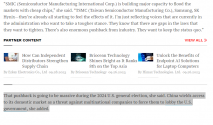A highly influential think-tank
(
) and their director, James Lewis has more formally published "
THE END OF EXPORT CONTROLS", advocating for ending export controls to China. For reference, CSIS is ranked the #1 think-tank in the US and #1 top defense and national security think tank in the world (
)
Export controls are not a panacea, they
are a relic. Everyone says the United States and China are not in a new Cold War, but U.S. export controls suggest the exact opposite.
Export controls on industrial goods—“dual-use” controls—are often counterproductive because other countries respond to export controls by creating replacement technologies. The result is to undercut U.S. tech leadership. Huawei’s
that it will use Chinese-made 5G chips for its phones illustrates this.
The history of export controls is not a happy one.
A few examples show the damage export controls can create:
- In the 1980s, a Japanese firm sold machine tools to the Soviet Union that let the Soviets build quieter submarines. The United States imposed very tight controls on its machine toolmakers, with the result that most were driven out of business, leaving the United States dependent on foreign suppliers (including China) for machine tools.
- In the 1980s, the United States allowed China to launch U.S. satellites, and the Chinese learned from this how to improve their space launch capabilities. The United States responded by blocking all exports of satellites and their components, imposing onerous licensing conditions on European satellite makers. In response, the Europeans built their own component suppliers (sometimes with subsidies from the European Union) to replace U.S. companies. U.S. companies permanently lost market share and some of the smaller U.S. suppliers exited the satellite business. China accelerated its space efforts and now launches more satellites than the United States.
- The United States restricted software encryption exports until 1999, forbidding the export of strong encryption. The result, at the dawn of the internet age, was that U.S. software makers were being displaced by foreign companies until export controls were removed.
- In the early 2000s, the United States tried to restrict Chinese access to high performance computer chips (CPUs) for national security reasons. The Department of Commerce even of keeping China “two generations behind.” Chips are made in the billions, making it hard to restrict sales, and older chips can be substituted for the most modern ones and one result was to inspire the Chinese to try harder to build their own chip industry.
Export controls were a sleepy legacy of Cold War foreign policy. They have been reenergized by competition with China, but the world has changed. China and the West are not bifurcated by an Iron Curtain. There is extensive trade and travel between them, while there was almost none with the Soviet Union. China, while it has extensive problems, is not the economically moribund USSR.
The United States and Chinese tech sectors are deeply connected, creating an interdependence that current tech transfer polices cannot manage.
Export controls lead other countries to develop workarounds, either by building their own industries or by finding alternative technologies. This is much easier to do in the interconnected twenty-first century than it was in the twentieth. The result can be a reduction, often permanent, in U.S. companies’ market share of the controlled technology. National security hawks may complain about this, but it is unavoidable and ignoring this history only guarantees
self-inflicted damage. Semiconductors are a prime example of this risk.
This administration and Congress correctly identified semiconductors as the core technology for tech competition with China. The CHIPS and Science Act and other measures intended to strengthen U.S. chipmaking are valuable steps. Slowing China’s progress in building its own semiconductor industry is good goal, but only if done in a way avoids choking Western industry and incentivizing opponents at the same time. Unfortunately, this is what the United States is doing.
U.S. policy needs to distinguish between semiconductors and their production. The administration’s work with Japan and the Netherlands to block exports of semiconductor manufacturing equipment have set China back years. In contrast,
restrictions on export of U.S. chips have only accelerated Chinese efforts to build its own industry through subsidies and espionage. Chinese manufacturers would still prefer to buy from U.S. chipmakers, since Chinese-made chips are not as good as U.S. versions, but they are good enough. Fears about China getting advanced chips to use for artificial intelligence reflects a misunderstanding of artificial intelligence technology and will not work any better than the efforts 20 years ago to prevent
China from building high-performance computers.
There are export controls that make sense. U.S. and allied countries’ prohibitions on arms sales to China remain crucial. Export controls on proliferation-related technologies, while not effective against China (which is doing quite well in missiles and weapons of mass destruction without U.S. help), are important for slowing Iran and North Korea. But export controls on most dual-use goods, particularly commodities goods like chips, harm the United States.
The best policy is to export chips to China, but not their production technology. No one want to be soft on China, but
restrictions on chip exports do more harm than good in tech competition.
